#dr adam splitter
Text
Wednesday

Wednesday was both Mata and Adam's day off. While the latter spend his morning studying, as usual, Mata went to the town's arcade. It was a funky joint, located in the old walls of a castle. Mata didn't meet anybody interesting, except for a man in a topper that clearly cheated at playing cards.



When she was back home, Mata convinced Dr. Splitter to go out with her for some hours. They went on a walk and arrived at the old abandoned factory.

Both of them were curious and so they went inside, where nobody but the two of them were.





One thing let to another and so they didn't use the old photo booth to take any pictures.

Back at home, Mata was a little worried, when she noticed that Dr. Splitter felt comfortable enough around her now, to walk around in his underwear.
Mata: Adam, I hope we can agree on, that Steve must not know about this, right?
Adam: O-of course Mata. Everything went so fast between us, I don't think he would understand. I-I'll give you two the space you need.
That was good to know. Mata got into the shower and when she took out the trash later, she found a cute ginger cat by the can.


Mata: Aww, aren't you just the cutest lil thing?

Mata and Steve weren't the only animal lovers in the household. But while their affection mostly focused on stray cats, Adam had a specific idea of the pet they should get.
12 notes
·
View notes
Text
Quantum interference in the service of information technology
Credit: CC0 Public Domain
Researchers from the Professors of Physics, University of Warsaw, in partnership with the University of Oxford and NIST, have actually revealed that quantum interference makes it possible for processing of big sets of information much faster and more precisely than with basic approaches. Their research studies might enhance applications of quantum innovations in expert system, robotics and medical diagnostics, for instance. The outcomes of this work have actually been released in Science Advances.
Contemporary science, medication, engineering and information technology need effective processing of information—still images, noise and radio signals, along with information originating from various sensing units and video cameras. Given That the 1970s, this has actually been accomplished by methods of the Quick Fourier Transform algorithm (FFT). The FFT makes it possible to effectively compress and transfer information, shop photos, broadcast digital TELEVISION, and talk over a smart phone. Without this algorithm, medical imaging systems based upon magnetic resonance or ultrasound would not have actually been established. Nevertheless, it is still too sluggish for numerous requiring applications.
To fulfill this objective, researchers have actually been pursuing years to harness quantum mechanics. This resulted in the advancement of a quantum equivalent of the FFT, the Quantum Fourier Transform (QFT), which can be recognized with a quantum computer system. As the quantum computer system at the same time processes all possible worths (so-called “superpositions”) of input information, the number of operations reduces substantially.
In spite of the fast advancement of quantum computing, there is a relative stagnancy in the field of quantum algorithms. Now researchers have actually revealed that this outcome can be enhanced, and in a rather unexpected method.
Quantum interference in service of information technology. Credit: M. Czerniawski, L. Kaluza, Promo Workplace UW
Kravchuk change
Mathematics explains numerous changes. One of them is a Kravchuk change. It is extremely comparable to the FFT, as it enables processing of discrete (e.g. digital) information, however utilizes Kravchuk operates to decay the input series into the spectrum. At the end of the 1990s, the Kravchuk change was “rediscovered” in computer system science. It ended up being exceptional for image and noise processing. It permitted researchers to establish brand-new and a lot more accurate algorithms for the acknowledgment of printed and handwritten text (consisting of even the Chinese language), gestures, indication language, individuals, and deals with. A lots years earlier, it was revealed that this change is perfect for processing low-grade, loud and distorted information, and therefore it might be utilized for computer system vision in robotics and self-governing lorries. There is no quick algorithm to calculate this change, however it ends up that quantum mechanics enables one to prevent this restriction.
“Holy Grail” of computer system science
In their short article released in Science Advances, researchers from the University of Warsaw—Dr. Magdalena Stobinska and Dr. Adam Buraczewski, researchers from the University of Oxford, and NIST, have actually revealed that the easiest quantum gate, which interferes in between 2 quantum states, basically calculates the Kravchuk change. Such a gate might be a widely known optical gadget—a beam splitter, which divides photons in between 2 outputs. When 2 states of quantum light enter its input ports from 2 sides, they interfere. For instance, 2 similar photons, which at the same time enter this gadget, lot into sets and come out together by the very same exit port. This is the popular Hong-Ou-Mandel result, which can likewise be reached states made of numerous particles. By interfering “packets” consisting of numerous identical photons (indistinguishability is extremely essential, as its lack ruins the quantum result), which encode the information, one gets a specialized quantum computer system that calculates the Kravchuk change.
The experiment was carried out in a quantum optical lab at the Department of Physics at the University of Oxford, where an unique setup was constructed to produce multiphoton quantum states, so-called Fock states. This lab is geared up with TES (Transmission Edge Sensors), established by NIST, which run at near-absolute absolutely no temperature levels. These detectors have a unique function: they can really count photons. This enables one to specifically check out the quantum state leaving the beam splitter and therefore, the result of the calculation. Most notably, such a calculation of the quantum Kravchuk change constantly takes the very same time, regardless of the size of the input information set. It is the “Holy Grail” of computer system science: an algorithm consisting of simply one operation, carried out with a single gate. Obviously, in order to get the result in practice, one requires to carry out the experiment numerous hundred times to get the stats. This is how every quantum computer system works. Nevertheless, it does not take long, since the laser produces lots of millions of multiphoton “packets” per second.
The outcome acquired by researchers from Poland, the UK and the United States will discover applications in the advancement of brand-new quantum innovations and quantum algorithms. Its variety of utilizes surpass quantum photonics, because a comparable quantum interference can be observed in various quantum systems. The University of Warsaw requested a global patent for this development. The researchers hope that the Kravchuk change will quickly discover usage in quantum calculation, where it will end up being a part of brand-new algorithms, specifically in hybrid quantum-classical computer systems that combine quantum circuits with “normal” digital designs.
Scientist construct transistor-like gate for quantum information processing – with qudits
More information:
“Quantum interference enables constant-time quantum information processing,” Science Advances (2019). DOI: 10.1126/sciadv.aau9674 https://advances.sciencemag.org/content/5/7/eaau9674
Supplied by
University of Warsaw
Citation:
Quantum interference in the service of information technology (2019, July 19)
recovered 21 July 2019
from https://phys.org/news/2019-07-quantum-technology.html
This file undergoes copyright. Apart from any reasonable dealing for the function of personal research study or research study, no
part might be replicated without the composed consent. The material is offered information functions just.
New post published on: https://livescience.tech/2019/07/21/quantum-interference-in-the-service-of-information-technology/
0 notes
Photo

----[]
http://www.bing.com/images/search?q=science+fiction+klassiker+bücher
http://www.bing.com/images/search?q=science+fiction
http://www.bing.com/images/search?q=flug+scheibe
http://www.bing.com/images/search?q=raum+schiff
--
https://www.tor-online.de/feature/buch/2019/03/die-100-besten-science-fiction-buecher-aller-zeiten
Die 100 besten Science-Fiction-Bücher (a..z)
Als es noch Menschen gab - Clifford Simak (City, 1952)
Andymon - Angela und Karlheinz Steinmüller (1982)
Auf zwei Planeten - Kurd Laßwitz (1897)
Auslöschung - Jeff VanderMeer (Annihilation, 2014)
Bedenke Phlebas - Iain M. Banks (Consider Phlebas, 1987)
Binti - Nnedi Okorafor (2015)
Blade Runner (Träumen Androide von elektrischen Schafen) - Philip K. Dick (Do Androids Dream Of Electric Sheep, 1968)
Blumen für Algernon - Daniel Keyes (Flowers for Algernon, 1966)
Der brennende Mann (Die Rache des Kosmonauten, Tiger! Tiger!) - Alfred Bester (The Stars My Destination, 1956)
Commander Perkins - H. G. Francis (1979, Hörspiele 1976)
Contact - Carl Sagan (1985)
Cyberabad - Ian McDonald (River of Gods, 2004)
Dämmerung - Octavia Butler (Dawn, 1987)
Dangerous Visions - Hrsg. Harlan Ellison (1967)
Die denkenden Wälder - Alan Dean Foster (Midworld, 1979)
Dhalgren - Samuel R. Delany (1975)
Doktor Ain - James Tiptree jr.
A Door Into Ocean – Joan Slonczewski
Die Drachenreiter von Pern - Anne McCaffrey (Dragonriders of Pern, 1977 - 2012)
Die drei Sonnen - Cixin Liu (三體 / 三体, 2008)
Die Ehen zwischen den Zonen Drei, Vier und Fünf - Doris Lessing (The Marriages Between Zones Three, Four and Five, 1980)
Ein Junge und sein Hund - Harlan Ellison (A Boy and His Dog, 1969)
Einsatz der Waffen - Iain M. Banks (Use of Weapons, 1990)
Enders Spiel - Orson Scott Card (Ender’s Game, 1985)
Es stirbt in mir - Robert Silverberg (Dying Inside, 1972)
Evolution - Stephen Baxter (2003)
Der ewige Krieg - Joe Haldeman (The Forever War, 1974)
Expanse-Reihe - James A. Corey (2011 - )
Fahrenheit 451 - Ray Bradbury (1953)
Frankenstein oder Der moderne Prometheus - Mary Shelley (Frankenstein or The Modern Prometheus, 2018)
Foundation-Trilogie - Isaac Asimov (Foundation, 1951)
Die Frau des Zeitreisenden - Audrey Niffenegger (The Time Traveler's Wife, 2003)
Freie Geister (Planet der Habenichtse, Die Enteigneten) Ursula K. Le Guin (The Dispossessed, 1974)
Fremder in einer fremden Welt - Robert Heinlein (Stranger in a Strange Land, 1961)
Der futurologische Kongress - Stanislaw Lem (Kongres futurologiczny, 1971)
Gateway - Frederik Pohl (1977)
Gelb - Jeff Noon (Vurt, 1993)
Die Haarteppichknüpfer - Andreas Eschbach (1995)
Hardboiled Wonderland und das Ende der Welt - Haruke Murakami (Sekai No owari to Hādoboirudo Wandārando, 1985
Herland - Charlotte Perkins Gilman (1915)
Hier sangen einst Vögel - Kate Wilhelm (Where Late the Sweet Birds Sang, 1976)
Die Hölle ist die Abwesenheit Gottes - Ted Chiang
Hyperion - Dan Simmons (1989)
Ich, der Robot - Isaac Asimov (I Robot, 1950)
Der illustrierte Mann - Ray Bradbury (The illustrated Man, 1951)
Die Insel des Dr. Moreau - H. G. Wells (The Island of Dr. Moreau, 1869)
Kinder der Zeit - Adrian Tchaikovsky (Children of Time, 2015)
Krieg der Klone - John Scalzi (Old Man’s War, 2005)
Krieg der Welten - H. G. Wells (The War of the Worlds, 1898)
Krieg mit dem Molchen - Karel Čapeks (Válka s mloky, 1936)
Die lange Erde - Stephen Baxter und Terry Pratchett (The Long Earth, 2012)
Der lange Weg zu einem kleinen, zornigen Planeten - Becky Chambers (The Long Way to a Small, Angry Planet, 2015)
Die Letzten der Menschheit – Walter Tevis (Mockingbird, 1980)
Der letzte Tag der Schöpfung - Wolfgang Jeschke
Liebe ist der Plan - James Tiptree jr.
Die linke Hand der Dunkelheit (Der Winterplanet) - (The Left Hand Of Darkness, 1969)
Little Brother - Cory Doctorow (2008)
Die Mars-Chroniken - Ray Bardbury (The Martian Chronicles, 1950)
Der Marsianer - Andy Weir (The Martian - 2001)
Die Mars-Trilogie (Roter Mars, Blauer Mars, Grüner Mars) - Kim Stanley Robinson (Red Mars, Blue Mars, Green Mars, 1992 - 1996)
Die Maschinen - Anne Leckie (Ancillary Justice, 2013)
Metro 2033 - Dmitri Glukhovsky (2007)
Der Mond ist eine herbe Geliebte (Revolte auf Luna, Mondpsuren) - Robert Heinlein (The Moon Is a Harsh Mistress, 1966)
Morgenwelt - John Brunner (Stand on Zansibar, 1968)
Nachspiel-Trilogie (Star Wars) - Chuck Wendig (Aftermath 2015 - 2017)
Neuromancer - William Gibson (1984)
Das Orakel vom Berge - Philip K. Dick (The Man in The High Castle, 1962)
Otherland von Tad Williams
Per Anhalter durch die Galaxis - Douglas Adams (The Hitchhiker's Guide to the Galaxy, 1979)
Perdito Street Station (Die Falter/Der Weber) - China Miéville (2000)
Perry Rhodan - Clark Dalton
Picknick am Wegesrand - Arkadi und Boris Strugatzki (Piknik na obotschinje, 1972)
Die Reise zum Mittelpunkt der Erde - Jules Verne (Voyage au centre de la terre, 1864)
Rendezvous mit Rama - Arthur C. Clark (Rendezvous with Rama, 1973)
Der Report der Magd - Margaret Atwood (The Handmaid’s Tale, 1985)
Ringwelt - Larry Niven (Ringworld, 1970)
Schöne neue Welt - Aldous Huxley (Brave New World, 1932)
Schlachthof 5 oder Der Kinderkreuzzug - Kurt Vonnegut (Slaughterhouse-Five, or The Children's Crusade: A Duty-Dance with Death, 1969)
Simulacron-3 - Daniel F. Galouye (1963)
Snow Crash - Neal Stephenson (1992)
Solaris - Stanislaw Lem (1961)
Spin - Robert Charles Wilson - (2005)
Der Splitter im Auge Gottes - Larry Niven und Jerry Pournelle (The Mote in God's Eye, 1974)
Starship Troopers (Sternenkrieger) - Robert Heinlein (1959)
Die Triffids - John Wyndham (The Day of the Triffids, 1951)
Ubik - Philip K. Dick (1969)
Uhrwerk Orange - Anthony Burgess (Clockwork Orange, 1962)
Das Unsterblichkeitsprogramm - Richard Morgan (Altered Carbon, 2002)
Utopia - Thomas Morus (De optimo rei publicae statu deque nova insula Utopia, 1516)
Die vergessene Welt - Arthur Conan Doyle
Was aus den Menschen wurde - Cordwainer Smith (2011, umfasst Kurzgeschichten von 1928 bis 1966)
Wer fürchtet den Tod - Nnedi Okorafor (Who Fears Death, 2010)
Wir waren außer uns vor Glück – David Marusek
Das Wort für Welt ist Wald - Ursula K. Le Guin (The Word For World Is Forest, 1972)
Der Wüstenplanet von Frank Herbert (Dune, 1965)
Die Zeitmaschine - H. G. Wells (The Time Machine, 1895)
Zerrissene Erde - N. K. Jemisin (The Fifth Season. 2015)
1984 - George Orwell (1949)
2001 - Arthur C. Clark (1968)
20.000 Meilen unter dem Meer - Jules Verne (Vingt mille lieues sous les mers, 1869)
--
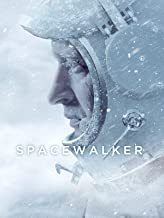
https://www.amazon.de/Science-Fiction-Bücher/s?k=Science+Fiction
--
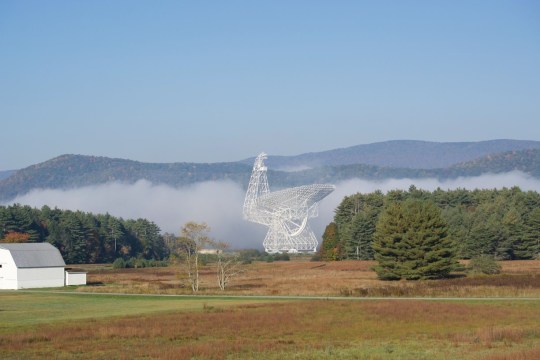
national radio quiet zone
https://science.nrao.edu/facilities/gbt/interference-protection/nrqz

http://www.landesmuseum.at/de/ausstellungen/detail/paul-kranzler-andrew-phelps-es-war-einmal-in-amerika.html

--

void

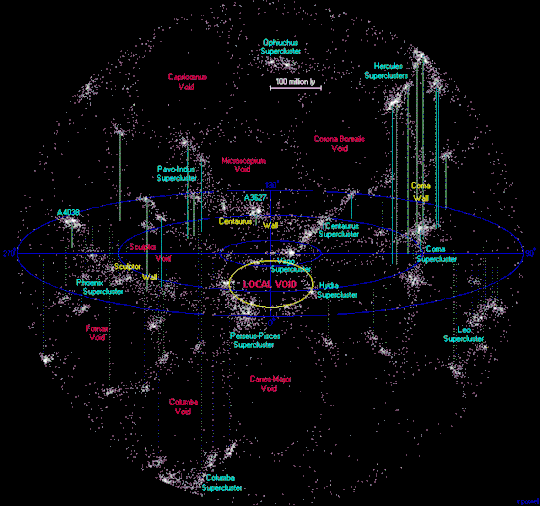
https://en.wikipedia.org/wiki/Local_Void
Cosmicflows-3: Cosmography of the Local Void [] https://arxiv.org/abs/1905.08329
--
https://twitter.com/ESA # https://sci.esa.int/web/juice/home/
0 notes
Text
Quantum interference in the service of information technology
https://sciencespies.com/physics/quantum-interference-in-the-service-of-information-technology/
Quantum interference in the service of information technology


Credit: CC0 Public Domain
Scientists from the Faculty of Physics, University of Warsaw, in collaboration with the University of Oxford and NIST, have shown that quantum interference enables processing of large sets of data faster and more accurately than with standard methods. Their studies may boost applications of quantum technologies in artificial intelligence, robotics and medical diagnostics, for example. The results of this work have been published in Science Advances.
Contemporary science, medicine, engineering and information technology demand efficient processing of data—still images, sound and radio signals, as well as information coming from different sensors and cameras. Since the 1970s, this has been achieved by means of the Fast Fourier Transform algorithm (FFT). The FFT makes it possible to efficiently compress and transmit data, store pictures, broadcast digital TV, and talk over a mobile phone. Without this algorithm, medical imaging systems based on magnetic resonance or ultrasound would not have been developed. However, it is still too slow for many demanding applications.
To meet this goal, scientists have been trying for years to harness quantum mechanics. This resulted in the development of a quantum counterpart of the FFT, the Quantum Fourier Transform (QFT), which can be realized with a quantum computer. As the quantum computer simultaneously processes all possible values (so-called “superpositions”) of input data, the number of operations decreases considerably.
In spite of the rapid development of quantum computing, there is a relative stagnation in the field of quantum algorithms. Now scientists have shown that this result can be improved, and in a rather surprising way.
Quantum interference in service of information technology. Credit: M. Czerniawski, L. Kaluza, Promotion Office UW
Kravchuk transform
Mathematics describes many transforms. One of them is a Kravchuk transform. It is very similar to the FFT, as it allows processing of discrete (e.g. digital) data, but uses Kravchuk functions to decompose the input sequence into the spectrum. At the end of the 1990s, the Kravchuk transform was “rediscovered” in computer science. It turned out to be excellent for image and sound processing. It allowed scientists to develop new and much more precise algorithms for the recognition of printed and handwritten text (including even the Chinese language), gestures, sign language, people, and faces. A dozen years ago, it was shown that this transform is ideal for processing low-quality, noisy and distorted data, and thus it could be used for computer vision in robotics and autonomous vehicles. There is no fast algorithm to compute this transform, but it turns out that quantum mechanics allows one to circumvent this limitation.
“Holy Grail” of computer science
In their article published in Science Advances, scientists from the University of Warsaw—Dr. Magdalena Stobinska and Dr. Adam Buraczewski, scientists from the University of Oxford, and NIST, have shown that the simplest quantum gate, which interferes between two quantum states, essentially computes the Kravchuk transform. Such a gate could be a well-known optical device—a beam splitter, which divides photons between two outputs. When two states of quantum light enter its input ports from two sides, they interfere. For example, two identical photons, which simultaneously enter this device, bunch into pairs and come out together by the same exit port. This is the well-known Hong-Ou-Mandel effect, which can also be extended to states made of many particles. By interfering “packets” consisting of many indistinguishable photons (indistinguishability is very important, as its absence destroys the quantum effect), which encode the information, one obtains a specialized quantum computer that computes the Kravchuk transform.
The experiment was performed in a quantum optical laboratory at the Department of Physics at the University of Oxford, where a special setup was built to produce multiphoton quantum states, so-called Fock states. This laboratory is equipped with TES (Transmission Edge Sensors), developed by NIST, which operate at near-absolute zero temperatures. These detectors possess a unique feature: they can actually count photons. This allows one to precisely read the quantum state leaving the beam splitter and thus, the result of the computation. Most importantly, such a computation of the quantum Kravchuk transform always takes the same time, regardless of the size of the input data set. It is the “Holy Grail” of computer science: an algorithm consisting of just one operation, implemented with a single gate. Of course, in order to obtain the result in practice, one needs to perform the experiment several hundred times to get the statistics. This is how every quantum computer works. However, it does not take long, because the laser produces dozens of millions of multiphoton “packets” per second.
The result obtained by scientists from Poland, the United Kingdom and the United States will find applications in the development of new quantum technologies and quantum algorithms. Its range of uses go beyond quantum photonics, since a similar quantum interference can be observed in many different quantum systems. The University of Warsaw applied for an international patent for this innovation. The scientists hope that the Kravchuk transform will soon find use in quantum computation, where it will become a component of new algorithms, especially in hybrid quantum-classical computers that merge quantum circuits with “normal” digital layouts.
Explore further
Researchers build transistor-like gate for quantum information processing – with qudits
More information:
“Quantum interference enables constant-time quantum information processing,” Science Advances (2019). DOI: 10.1126/sciadv.aau9674 https://advances.sciencemag.org/content/5/7/eaau9674
Provided by
University of Warsaw
Citation:
Quantum interference in the service of information technology (2019, July 19)
retrieved 19 July 2019
from https://phys.org/news/2019-07-quantum-technology.html
This document is subject to copyright. Apart from any fair dealing for the purpose of private study or research, no
part may be reproduced without the written permission. The content is provided for information purposes only.
#Physics
0 notes
Text
June 4, 2017
Ethereum News and Links
Top
Geth v1.6.5 released in a hurry this week, because...
The DevCon2 DoS attacker returned. Fortunately, u/arrnx gave us an early warning and the Geth team had a fix in a couple hours.
ETC core dev Cody Burns follows the DoS attacker's transactions and determines that both Kraken and Poloniex know the attacker's identity.
Ethereum Wallet and Mist updated to geth 1.6.5
Crypto Tokens: A Breakthrough in Open Network Design by Chris Dixon
Protocol
Are Ethereum Contracts Vulnerable to Hash Table Poisoning Attacks? Interesting EVM discussion.
State channel reading list
Zk-snarks for scalability?
Yoichi talks through the EIPs in Metropolis
Help Wanted: Metropolis QA/Testing
Stuff for developers
How Truffle is making installation issues a thing of the past
On This Week in Startups, Digg founder Kevin Rose talked at length about token sales and how he would build Digg using Ethereum. (Video got taken down). This isn't the first time he's mentioned it . . . and he wants to talk to an Ethereum developer about it. You can tweet him @kevinrose
The simple Dai from Maker called Sai is coming soon
Both the Status and Token $25k virtual hackathons are ongoing.
Ecosystem
Swarm's invite-only DevCon0 style summit in Berlin
FirstBlood's first Dota2 tournament is June 12th
Lots of interesting comments on the security challenges of decentralized VPN
Securing loans with ENS deposits
Setting up an ENS reverse record ('Ethereum Caller ID')
Miners should go back to the normal "target gas limit"
What's the difference between AdChain and BAT?
The Etherian's project updates
The Kremlin: Meeting with founder of Ethereum project Vitalik Buterin
In the last month, Vitalik has also met with officials in China and India
Project Announcements
OpenANX -- white paper
TenX debit card. White paper
Get to know Catallax: Demurrage, Catch Up, and Pref Dividends
Contracts for Difference exchange on Kovan testnet
Project Updates
Augur: A Roadmap for what's next
Augur has about 15m USD at current asset prices
Trustlines PoC on the testnet, aiming at a beta release for DevCon3
Aragon orgs can use Ox to operate with any token
Melonport May update
iEx.ec fortnight update #2
The Grid+ demo app
Raine Revere with a technical overview of Prism
Update on Prism Fees
Interviews and Talks
A few Token Summit videos: Kik, Brian Armstrong on Token, Governance, and many more
Ox founder Will Warren talks to Adam Draper
SingularDTV's Zach LeBeau on UpNext podcast
Vitalik in Russian
Tim Ferriss interviews Nick Szabo and Naval Ravikant
At 95:40, Nick slips and says, "When I created Bitcoin, er gold..."
I've started thinking of Szabo as a proof-of-work maximalist. It explains this tweet where Nick strangely misreads PoS. (If you're curious, read Minimal Slashing Conditions)
Token Sales
Status sale details and ways to earn SGT. Plus promo video
ConsenSys's Mike Goldin discusses AdChain
Dr. Petty: A Look at the BAT Token Distribution
Codetract on how to get into the BAT sale
Demian Brener on the 4 stages of token sales
I wrote on EvanVanNess.com why I decided to start Token Sale Calendar
Token Sale Structures
Alex van de Sande shares some PoC code for continuous token sale
Tom Ding's discussion on responsible protocol funding
Luke Duncan's proposal: Max time frame, max gas price, proportional tokens to total raised, but burn extra ETH
Whether the extra ETH goes to founders or to 0xBURN doesn't affect the price paid by the people over the cap
Nice comment thread on how to fix token sale structures, including a few from Patri Friedman.
I'm baffled that so many founders don't do reverse Dutch auctions. Why do founders like selling their tokens way below market value in order to make whales richer?
General
Devcon3 registration is now open.
Reuters writes up the (paywall) WSJ report that Coinbase is raising at a 1b valuation
What is Coinbase's strategy? Fred Wilson likes it.
Search engine DuckDuckGo now has ETH price conversion
Jeffrey Berns: Is ENS squatting illegal?
Fred Wilson's thoughts on VCs in the ICO age
Some hype in our community about "Singapore Dollar Tokenized on Ethereum." If you read the report, that hype seems quite a bit over its skis.
Imogen Heap in HBR: Blockchain Could Help Musicians Make Money Again
Canadian exchange Quadriga lost ~$15m USD by unnecessarily using a splitter
William Mougayar's ultimate blockchain reading list and Chris Dixon's crypto token reading list.
Dates of note
From Token Sale Calendar:
June 12 -- Bancor sale begins
June 13 -- SuperDAO sale begins
June 15 -- SONM sale begins
June 17 -- Status sale begins
June 22 -- OpenANX sale begins
June 26 -- Adchain sale begins
June 27 -- Omise Go sale begins
June 30 -- Santiment sale begins
Nov 1-4 -- DevCon3
Ongoing token sales:
Braid
Dcorp
Beth
[I aim for a relatively comprehensive list of Ethereum sales, but make no warranty as to even whether they are legit; as such, I thus likewise warrant nothing about whether any will produce a satisfactory return. I have passed the CFA exams, but this is not investment advice. If you're interested in what I do, you can find my investing thesis and token sale appreciation strategies in previous newsletters.]
Errors or additions: [first name] @ticketleap.com
The link for sharing
The best compliment you can give this is to share or upvote: http://www.weekinethereum.com/post/161587118778/june-4-2017
Follow me on Twitter? @evan_van_ness
This newsletter is supported by Status.im. But in case you still want to send Ether (or tokens?): 0x96d4F0E75ae86e4c46cD8e9D4AE2F2309bD6Ec45
Sign up to receive the weekly email.
1 note
·
View note
Text
Monday

As it was their moving day, Steve was allowed to stay at home from school so he could spend the whole morning playing his favorite video game. Dr. Splitter's engine was really great, not to compare to the run-down they owned when they still lived with Dad.


Mata: Oh, I see you're pursuing your creative streak, Dr. Splitter. It's so important to train all the fields a Sim could gain skills in.
Adam: Oh, you-you think so, Mrs. Dore? I don-don't know, I-I'm still a beginner in the creative field. Um.. wou-would you... I mean... don't you mind talking to me as... as lightly dressed as...
Mata: *laughs* Ah, Dr. Splitter, I don't mind at all. And a man of your standing shouldn't mind too. I'm positive, I've seen enough women like me.
Adam didn't know what to say. He never had seen a woman like Mata. A distant memory of taking baths with his mother came to his mind, she was the only woman he'd ever seen in less than a lab coat. They chit-chatted for some more and suddenly Mata pulled him into a tender hug.
Mata: Thank you again for letting us stay with you, Adam.
He had never heard his name be spoken like this.

Mata sprung away from Dr. Splitter when she heard the door open.
Steve: Mom! Can you believe it?! I made a new high score! Without all the lag I'm really great at SSX3!




Around lunch time, some neighbors came over to meet the new inhabitants of Emerald Heighs. Claire Voyante was the leader of a girls group home, April DeShong a local housewife and Rocky Stone the co-founder of a local interest group. They had a nice day and Steve could show off his SSX3 skills.

Steven knew that his mother wanted him to go to college as soon as he was old enough but Steven didn't know if he really wanted to go. Being new in town was hard enough, wouldn't it be even harder to leave right away again and start over AGAIN?
#the sims 2#the custom uberhood#emerald heights#splitter family#dr adam splitter#mata dore#steve dore#claire voyante#april deshong#rocky stone#round 1
12 notes
·
View notes
Text
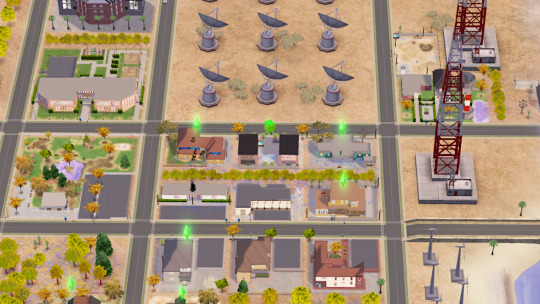
Our next step is with one of the more scientific areas of Emerald Heights, near the ominous oil field...
Splitter:
Dr. Adam Splitter has been living on Foundation property so he could monitor all his delicate experiments 24/7 for years, but now the Foundation has saddled him with an assistant! And she comes with a teen-age boy in tow. Can they adjust to life with the renowned reclusive scientist? Or will they all make each other Mad?
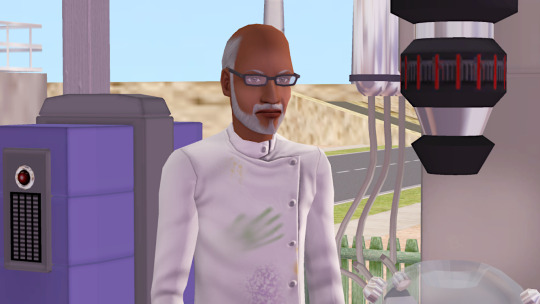
He lives across from the Science Center so he can monitor experiments at all hours, and has done so for years; but you blow up one lab, one time, just once, and suddenly they're all over you threatening to cut off the grant money if you don't get a younger assistant. And technically the house belongs to the Foundation so the board can move in whoever they want.
Dr. Adam Splitter:
male, elder, Sim
Knowledge/Fortune (Max out 7 Skills)
Virgo (10/0/8/7/0)
Science career, OTH: Sports
Traits: Neat, Brooding, Vehicle Enthusiast, Computer Whiz, Materialistic

After her divorce, she'd been worried about making ends meet, but she's been so lucky! Not only does she get to work personally with the great Dr. Splitter, but she and her boy Steve get free housing! Okay, it's a little cramped; but she's far away from all the humiliating scenes of her marriage and that covers a multitude of sins. Steve's pouting, but he'll pull it together. He's a good boy, really.
Mata Dore:
female, adult, Sim
Knowledge/Family (Max out 7 Skills)
Cancer (5/5/5/5/5)
Science career, OTH: Sports
Traits: Disciplined, Friendly, Match Enthusiast, Genius, Nurturing

The divorce is a bummer, the move is a bummer, sharing a room with his mother and his house with a crabby senile dude (Assistant, yeah right, try babysitter, Mom doesn't know when she's being exploited) is a megabummer. On the bright side, though - that house out back is crawling with hot teenage girls! So maybe it won't be that bad.
Steve Dore:
male, teenager, Sim
Romance (Have 20 simultaneous Lovers)
Saggitarius (0/10/10/10/0)
Public School, OTH: Nature
Traits: Adventurous, Childish, Angler, Commitment Issues
Challenges Rolled for:
- round: Public woohoo: woohoo in the photo booth or change rooms.
- season: Large pet adoption: Your sims have decided it's too quiet without the pitter-patter of furry paws and have decided to adopt a pet. Make a visit to the local pet shop, call the pet adoption agency, or make a pet in CAS.
- week: Regular Week: Nothing Major Happens
-> Mata will have a public woohoo and Adam will adopt a large dog.
#the sims 2#the custom uberhood#emerald heights#splitter family#dr adam splitter#mata dore#steve dore#round 1#introduction post
11 notes
·
View notes
Text
Quantum interference in the service of information technology



Credit: CC0 Public Domain
Scientists from the Faculty of Physics, University of Warsaw, in collaboration with the University of Oxford and NIST, have shown that quantum interference enables processing of large sets of data faster and more accurately than with standard methods. Their studies may boost applications of quantum technologies in artificial intelligence, robotics and medical diagnostics, for example. The results of this work have been published in Science Advances.
Contemporary science, medicine, engineering and information technology demand efficient processing of data—still images, sound and radio signals, as well as information coming from different sensors and cameras. Since the 1970s, this has been achieved by means of the Fast Fourier Transform algorithm (FFT). The FFT makes it possible to efficiently compress and transmit data, store pictures, broadcast digital TV, and talk over a mobile phone. Without this algorithm, medical imaging systems based on magnetic resonance or ultrasound would not have been developed. However, it is still too slow for many demanding applications.
To meet this goal, scientists have been trying for years to harness quantum mechanics. This resulted in the development of a quantum counterpart of the FFT, the Quantum Fourier Transform (QFT), which can be realized with a quantum computer. As the quantum computer simultaneously processes all possible values (so-called “superpositions”) of input data, the number of operations decreases considerably.
In spite of the rapid development of quantum computing, there is a relative stagnation in the field of quantum algorithms. Now scientists have shown that this result can be improved, and in a rather surprising way.
Quantum interference in service of information technology. Credit: M. Czerniawski, L. Kaluza, Promotion Office UW
Kravchuk transform
Mathematics describes many transforms. One of them is a Kravchuk transform. It is very similar to the FFT, as it allows processing of discrete (e.g. digital) data, but uses Kravchuk functions to decompose the input sequence into the spectrum. At the end of the 1990s, the Kravchuk transform was “rediscovered” in computer science. It turned out to be excellent for image and sound processing. It allowed scientists to develop new and much more precise algorithms for the recognition of printed and handwritten text (including even the Chinese language), gestures, sign language, people, and faces. A dozen years ago, it was shown that this transform is ideal for processing low-quality, noisy and distorted data, and thus it could be used for computer vision in robotics and autonomous vehicles. There is no fast algorithm to compute this transform, but it turns out that quantum mechanics allows one to circumvent this limitation.
“Holy Grail” of computer science
In their article published in Science Advances, scientists from the University of Warsaw—Dr. Magdalena Stobinska and Dr. Adam Buraczewski, scientists from the University of Oxford, and NIST, have shown that the simplest quantum gate, which interferes between two quantum states, essentially computes the Kravchuk transform. Such a gate could be a well-known optical device—a beam splitter, which divides photons between two outputs. When two states of quantum light enter its input ports from two sides, they interfere. For example, two identical photons, which simultaneously enter this device, bunch into pairs and come out together by the same exit port. This is the well-known Hong-Ou-Mandel effect, which can also be extended to states made of many particles. By interfering “packets” consisting of many indistinguishable photons (indistinguishability is very important, as its absence destroys the quantum effect), which encode the information, one obtains a specialized quantum computer that computes the Kravchuk transform.
The experiment was performed in a quantum optical laboratory at the Department of Physics at the University of Oxford, where a special setup was built to produce multiphoton quantum states, so-called Fock states. This laboratory is equipped with TES (Transmission Edge Sensors), developed by NIST, which operate at near-absolute zero temperatures. These detectors possess a unique feature: they can actually count photons. This allows one to precisely read the quantum state leaving the beam splitter and thus, the result of the computation. Most importantly, such a computation of the quantum Kravchuk transform always takes the same time, regardless of the size of the input data set. It is the “Holy Grail” of computer science: an algorithm consisting of just one operation, implemented with a single gate. Of course, in order to obtain the result in practice, one needs to perform the experiment several hundred times to get the statistics. This is how every quantum computer works. However, it does not take long, because the laser produces dozens of millions of multiphoton “packets” per second.
The result obtained by scientists from Poland, the United Kingdom and the United States will find applications in the development of new quantum technologies and quantum algorithms. Its range of uses go beyond quantum photonics, since a similar quantum interference can be observed in many different quantum systems. The University of Warsaw applied for an international patent for this innovation. The scientists hope that the Kravchuk transform will soon find use in quantum computation, where it will become a component of new algorithms, especially in hybrid quantum-classical computers that merge quantum circuits with “normal” digital layouts.
Researchers build transistor-like gate for quantum information processing – with qudits
More information:
“Quantum interference enables constant-time quantum information processing,” Science Advances (2019). DOI: 10.1126/sciadv.aau9674 https://advances.sciencemag.org/content/5/7/eaau9674
Provided by
University of Warsaw
Citation:
Quantum interference in the service of information technology (2019, July 19)
retrieved 21 July 2019
from https://phys.org/news/2019-07-quantum-technology.html
This document is subject to copyright. Apart from any fair dealing for the purpose of private study or research, no
part may be reproduced without the written permission. The content is provided for information purposes only.
New post published on: https://www.livescience.tech/2019/07/21/quantum-interference-in-the-service-of-information-technology/
0 notes